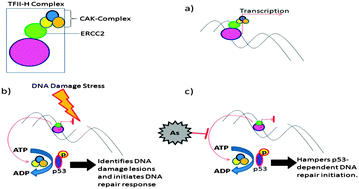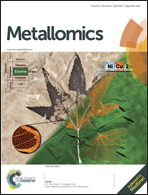Arsenic-induced promoter hypomethylation and over-expression of ERCC2 reduces DNA repair capacity in humans by non-disjunction of the ERCC2–Cdk7 complex†
Abstract
Arsenic in drinking water is of critical concern in West Bengal, India, as it results in several physiological symptoms including dermatological lesions and cancers. Impairment of the DNA repair mechanism has been associated with arsenic-induced genetic damage as well as with several cancers. ERCC2 (Excision Repair Cross-Complementing rodent repair, complementation group 2), mediates DNA-repair by interacting with Cdk-activating kinase (CAK) complex, which helps in DNA proof-reading during transcription. Arsenic metabolism alters epigenetic regulation; we tried to elucidate the regulation of ERCC2 in arsenic-exposed humans. Water, urine, nails, hair and blood samples from one hundred and fifty seven exposed and eighty eight unexposed individuals were collected. Dose dependent validation was done in vitro using HepG2 and HEK-293. Arsenic content in the biological samples was higher in the exposed individuals compared with the content in unexposed individuals (p < 0.001). Bisulfite-modified methylation specific PCR showed a significant (p < 0.0001) hypomethylation of the ERCC2 promoter in the arsenic-exposed individuals. Densitometric analysis of immunoblots showed a nearly two-fold increase in expression of ERCC2 in exposed individuals, but there was an enhanced genotoxic insult as measured by micronuclei frequency. Immuno-precipitation and western blotting revealed an increased (p < 0.001) association of Cdk7 with ERCC2 in highly arsenic exposed individuals. The decrease in CAK activity was determined by observing the intensity of Ser392 phosphorylation in p53, in vitro, which decreased with an increase in arsenic dose. Thus we infer that arsenic biotransformation leads to promoter hypomethylation of ERCC2, which in turn inhibits the normal functioning of the CAK-complex, thus affecting DNA-repair; this effect was highest among the arsenic exposed individuals with dermatological lesions.


 Please wait while we load your content...
Please wait while we load your content...